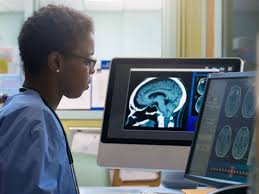NextGen radiologists love AI
Embracing new technologies is not new to radiologists, but AI will be central to the future as an invaluable tool to the NextGen radiologist.
Medical imaging is the crucial part of the diagnostic pathway to support diagnosis, ongoing monitoring, and treatment of a range of conditions, including cancer. The use of imaging activity – Magnetic Resonance Imaging (MRI) and Computed Tomography (CT) – has been growing rapidly for several decades and is likely to continue due to ageing population, rise in chronic diseases and access to healthcare technologies in emerging economies.
Interpreting medical imaging scans is a highly skilled ‘manual’ job requiring many years of training. As demand of radiologists outstrips supply, the range and complexity of imaging methods grow with advancements in scanners, resulting in an increased number of patients waiting longer for their image examinations and diagnostics.1 It is well established that such delays can have an impact on patient care and treatment outcomes – rapid and early detection can lead to higher survival rates for some of the most common types of cancer. Can Artificial Intelligence (AI) based tools help improve patient outcomes?
AI can be a tool in imaging – for the detection, characterisation and augmentation of workflows in radiology, driving higher efficiencies, and allowing radiologists to perform more valuable clinical interpretations and decisions.
The Potential Of AI in Radiology
In the past decades, medical imaging has evolved from projection to cross-sectional images such as MRI, becoming more complex and data rich; this provides the opportunity to identify findings that humans can or cannot detect. AI has the potential to replace many of the routine detection, characterisation and quantification tasks currently performed by radiologists using cognitive abilities.
AI can also be used as an adjunct to radiologist interpretation – based on machine learning algorithms – and the algorithms have been shown to detect some of the most common brain cancers and neurodegenerative diseases such as Alzheimer’s disease. 2
Deep Learning (DL) is a class of machine learning that uses multiple layers to progressively extract and discover complicated patterns from the raw input; this makes DL a natural fit for image processing and analysis.3 Data derived from radiomics – an emerging field that deals with the high-throughput extraction of quantitative peculiar features from radiological images – such as intensity, shape, texture, wavelength, etc., can be extracted from medical images and integrated in DL algorithms, providing valuable information for the prediction of treatment response, such as differentiating between benign and malignant tumours.
AI is not a threat to radiologists, but rather is a tool to improve and optimise radiologists’ workflow (as is the case in many industries). It will allow radiologists to perform more of the key tasks such as integrating patients’ clinical and imaging information, more professional interactions, becoming more visible to patients and playing a vital role in integrated clinical teams.
NextGen Radiologist
Embracing new technologies is not new to radiologists, as since the beginnings of its history, radiology has been undergoing continuous technology advancement.
Collaborating with radiologists and getting them informed about AI is essential for the validation and standardization of AI tools in clinical practice. Experienced radiologists are a key part of the DL learning process, as the algorithms rely on their studies and findings. Further, radiologists play a critical role in identifying the AI use-cases for clinical applications, as the final user of the algorithms’ output.
The NextGen radiologist should be aware of the basic principles of AI/DL systems, of the characteristic of datasets to train them, know how to interpret data, and importantly, know their limitations. AI will not replace radiologists, but the radiologists who take advantage of the potential of AI will ultimately replace those who do not rise to this crucial challenge and technology advancements.
AI will play a central role in the future of radiology.
References:
- Horizon Scanning: An evaluation of imaging capacity across the NHS in England
- Artificial Intelligence in Medical Imaging: NIH Dec 2018 publication
- An overview of Deep Learning in medical imaging focusing on MRI: ScienceDirect
